LokManthan 2024, held at Shilpakala Vedika, Bhagyanagar, from November 21 to 24, emerged as a significant colloquium aimed at fostering a deeper understanding of Bharat’s cultural and intellectual heritage. Organised by Prajna Pravah and Pragna Bharati, this biennial event brought together a diverse array of thinkers, academicians, artists, and practitioners from across the country to engage in meaningful dialogues on the nation’s rich traditions and contemporary relevance.
The central theme for LokManthan 2024 was “LokAvalokan,” which translates to a contemplation of the thought processes, practices, and established systems of Lok traditions. This theme is structured around three core components:
Lok Vichaar: Exploring the thought processes that have shaped Bharat’s culture in harmony with nature and the environment.
Lok Vyavahaar: Examining practices and traditions that have evolved, aligning with prevailing thoughts, circumstances, and regions.
Lok Vyavastha: Analysing established systems and institutions, catalysing holistic growth, progress and security across diverse communities. The three-day sessions were effectively guided and managed by Giridhar Mamidi, a member of Pragna Bharati, alongside Prafulla Ketkar, Editor of Organiser Weekly. Inauguration of Exhibition
Day 0: November 21, 2024 Former Vice-President M Venkaiah Naidu inaugurated the exhibition festival at Shilparamam on November 21. The dignitaries who graced the occasion were Union Minister for Coal & Mines G Kishan Reddy, Minister of Culture in the Telangana Government Jupalli Krishna Rao and T Hanuman Chowdary, Chairperson of Pragna Bharati.
On this occasion, Venkaiah Naidu said such events and festivals are a continuum of the cultural heritage of our ancestors and are an important step in the process of decolonisation. He said that Sanatan Dharma is the most glorious and sacred heritage, which worships the environment and feeds cows, snakes, and birds, too. We worship all elements of nature. Our culture and Bharatiya languages, especially our mother tongues, music and dances, crafts, textiles and festivals, have to be protected and sustained. We should not get inundated with Western English culture and foreign languages.
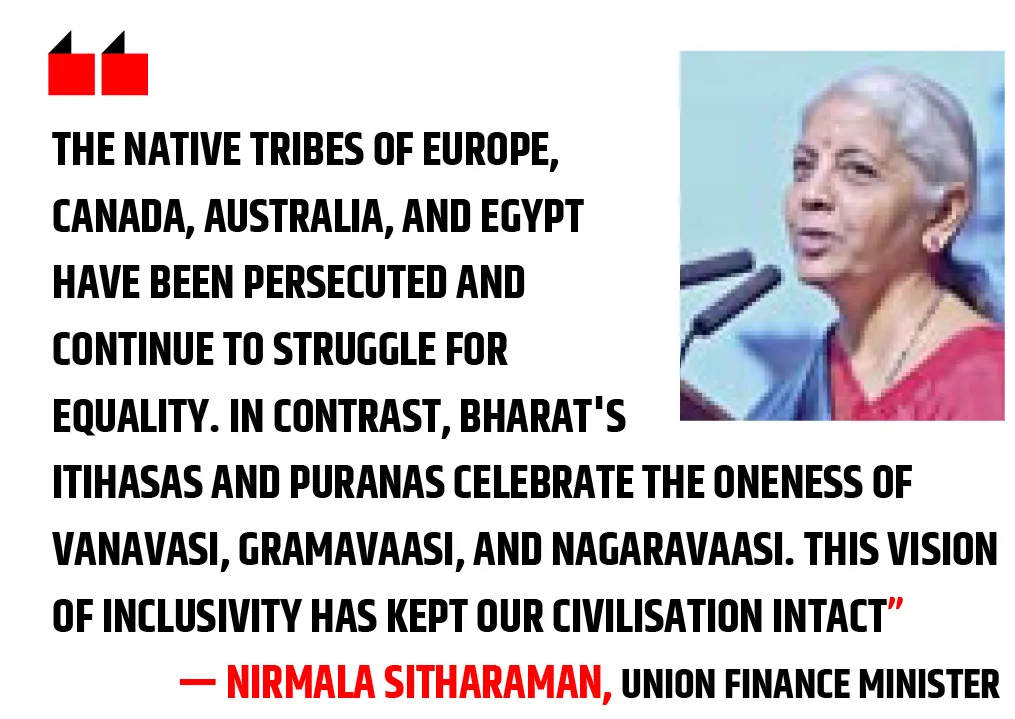
“Many great stalwarts, including the President, Prime Minister and several Supreme Court justices, all studied in their mother tongues. We should wear our traditional clothes and follow our cultural traditions. We should rise early in the morning and do yoga to become Yogya Vyakti and lead a productive and fulfilling life. We need to protect our family system, which is ideal for the world; youngsters should respect elders and parents and continue our ancient cultural traditions. LokManthan presents a wonderful opportunity to immerse ourselves in the celebration of our Bharatiya culture”, said former Vice-President.
Jupalli Krishna Rao commended LokManthan organisers and thanked them for the opportunity provided by the Telangana State Government to partner with LokManthan. Dwisahasravadhani Sri Madugula Nagaphani Sarma, an exponent of the unique Telugu literary feat Avadhanam, blessed LokManthan with his extempore poetry in a blend of Sanskrit and Telugu.
Lokmata Punyashlok: The Resurgence of Bharatiya Lok
In LokManthan 2024, a show based on the life of Lokmata Punyashlok Ahilyabai Holkar, her valour and courage was showcased. The show highlighted how a woman led a Hindu resurgence, and rebuilt temples that were destroyed by Islamic invaders. During her reign, people lived peacefully, and she awakened the Hindus to reclaim their rights and dignity.
The show features the story of a modern girl who says that she doesn’t have freedom because her parents stop her from doing anything and impose restrictions on everything. She arrives in Maheshwar with the intention to commit sucide.
There, she meets a saint and a group of people who encourage her to learn about Rani Ahilyabai’s life and explore Maheshwar. Initially, the girl debates with them, expressing her “woke” views about personal freedom, but their logical arguments prompt her to reflect on her own choices and privileges, including the freedom to study, which she had not fully utilised.
An ISRO scientist visiting Maheshwar gives the girl a book on Rani Ahilyabai’s inspiring journey. Reading the book instills new energy in her, and she decides to stop living just for herself and begins working for the welfare of others, drawing inspiration from Ahilyabai’s selfless leadership and dedication to society. The show gives a lesson that true freedom lies in duty and selflessness. By embracing Rani Ahilyabai’s values, one can lead with courage, serve with compassion, and reclaim the dignity of our heritage.
In continuation of the inaugural day events, cultural celebrations were held at Shilpakala Vedika in the evening, and enriching programmes were designed to showcase the diversity and depth of Bharat’s artistic traditions. The events started with Kalasankarshini Pravesh by N Rachana. It was a graceful and spiritually uplifting art form that blends dance and music. Adding an international flavour, Armenia Group presented a musical performance, offering a cross-cultural experience for the audience. Bharat ki Beti, a powerful programme by Samskara Bharati paid tributes to the strength and resilience of women in Indian society. The evening featured a Jugalbandi performance by Dr Y Venkateswara Rao & party, showcasing the harmonious interplay between different classical music forms. To conclude the evening, Smt Begum Batool presented a soulful Bhajan-Kirtan, inviting the audience to engage in devotional singing and spiritual reflection.
Day 1
Inaugural Session
President Draupadi Murmu inaugurated LokManthan Bhagyanagar on November 22, the largest cultural festival of the country. While inaugurating the event, the President recollected her earlier presence at Ranchi LokManthan in 2018. She said the strong conceptual unity of Bharat is multi-hued like a rainbow, whether we are Vanvasi, Gramavasi or Nagarvasi, we are all Bharat-vasi. Our cultural heritage from ancient Bharat continues to be used for the worship of Surya, the Devi, etc. Our cultural values are reflected in our arts, literature, crafts, and various facets of our national life.
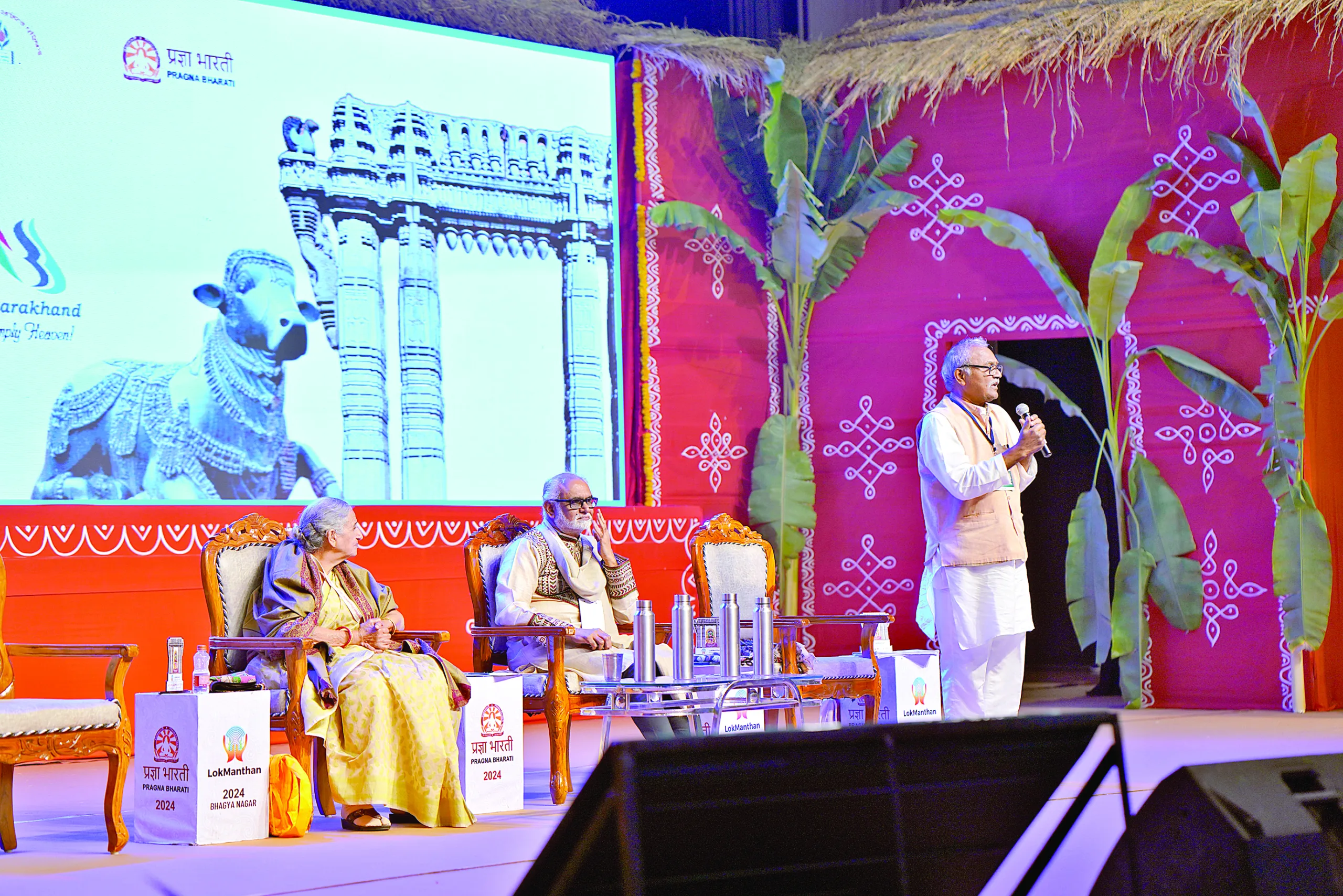
“The colonial rule not only disrupted our cultural traditions but also dismantled our well-functioning social, economic, and educational systems,” the President observed. “Today, our national consciousness is awakening, and we are progressively shedding the remnants of colonial influence. By renaming and reinstituting places of significance—such as Lok Kalyan Marg, Ganatantra Mandap, and Bharatiya Nyaya Devatha—we are restoring our heritage. These efforts are a vital part of reconnecting with our roots and honouring the true essence of Bharat.”
On this occasion, Lok Avalokan was also released by the President. Vishnudev Varma, Governor of Telangana, G Kishan Reddy, Union Minister, Telangana Government Minister Sitakka, Rashtriya Swayamsevak Sangh (RSS) Sarsanghchalak Dr Mohan Bhagwat, J Nand Kumar, National Convenor Prajna Pravah and Dr T Hanuman Chowdary, a Padmasree awardee, graced the stage during the inaugural session.
Finding the common links
A delegation of an ancient Armenian faith, called ‘Children of the Sun’, which came to Bhagyanagar to participate in the Lokmanthan 2024 conclave, expressed joy over the event uniting people who practice different faiths but follow the same principle of worshipping nature.
The delegation came to perform Sun worship rituals by performing Armenian traditional dances and chants. Talking to Organiser, Nayira, a member of the delegation, said that Armenian culture of worshipping nature is common to Bhartaiya ancient culture. She said they worship the Sun god at the Garni Temple, like Hindus, and it is the only remaining Pagan temple in Armenia.
Nayira said that, like Hindus, the ancient Armenians used to believe in idol worship, after the invasion of Christians, the idols of their Gods were demolished. The ancient Armenians called themselves ‘Children of the Sun’ as they worshipped a creator called Ara, a powerful deity of intelligence who manifests as the Sun. The worship was done by Priest Aakishti. Nayira told Organiser that the Sun is life, love and everything to them. “We too distribute sweets and sweet bread like Hindus distribute Prasadam, wishing for the well-being of others after worshipping the Sun God,” Nayira explained.
Stating that though Armenia was a Christian country now, Nayira said some Armenians still followed their ancient faith. The annual festival of worshipping the Sun God at the Garni temple comes in February.
Welcoming the guests, J Nandakumar briefed them about LokManthan and its journey and the idea behind it. G Kishan Reddy, as the chairman of the reception committee, commended LokManthan for its remarkable efforts in fostering intellectual churning and hoped that the manthan on the subjects of Lok would help in the path of making Viksit Bharat by 2047. The Telangana State Government Minister, Smt Sitakka, wished LokManthan a great success.
Describing LokManthan as a continuum of Bharat’s profound intellectual and cultural traditions, Governor Jishnu Dev Varma said that it encompasses Lok Sahitya, Kala, Parivartan, Arthik Vyavastha, Nyay Vyavastha, and Vidya Vyavastha. “This event will significantly strengthen our national and cultural bonds and serve as a powerful counter to divisive forces.”
Keynote Address by Shri Pawan Gupta, Founding Director, SIDH Foundation
In his keynote address, Pawan Gupta began by recounting his time working in the village of Mussoorie, where he immersed himself with the local community, observing first hand the deep wisdom of the villagers. “When I lived and worked among the villagers, I was struck by a paradox,” Gupta explained. “Though they were considered ‘illiterate’ by modern standards, their understanding of nature, agriculture, and life itself was profound and nuanced. Their wisdom was something I had never been taught in my formal education.”
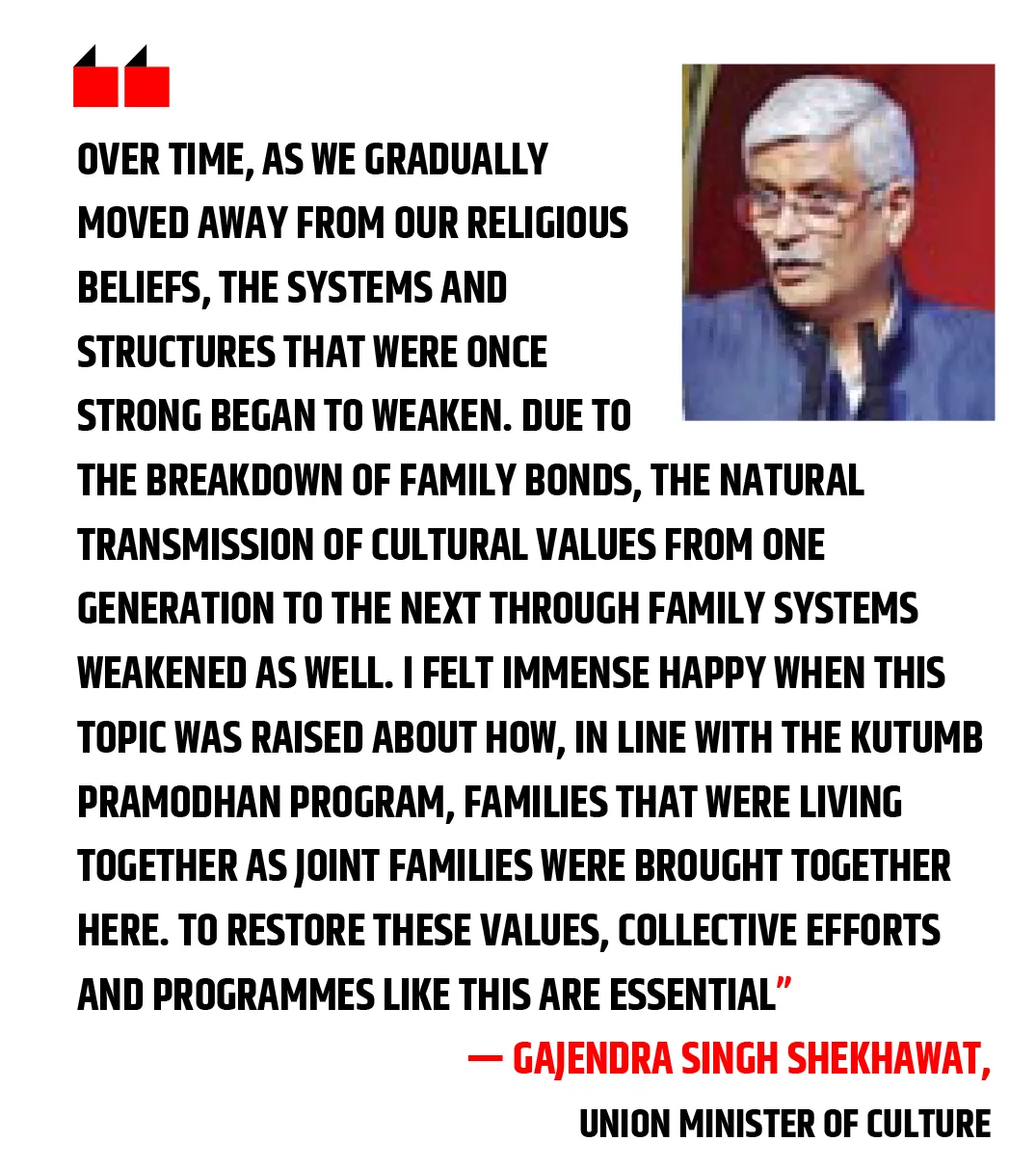
Gupta said, “This experience ignited a transformation in his thinking, one that became even more profound after he studied the research material of Dharampal, a scholar whose work on colonial Bharat and its education system had a lasting impact on his perspective. “Dharampal’s research, books like ‘Beautiful Tree’ changed the way I viewed Bharat and its knowledge systems. It made me realise that what we call ‘education’ today is far removed from the values and wisdom that have shaped our civilisation for millennia.”
“Perhaps our ancestors were neighbours”: Lithuanian people who share common traditions with Hindus
A group from Lithuania, a country in Europe, was at LokManthan to perform the fire ritual, with three members travelling to Hyderabad to share their rich cultural tradition. Speaking with Organiser, Eliyah, Gailwana, and Ya Wa Dijpatita explained the significance of the fire ritual in their culture.
The fire ritual is central to our traditions. Whether it is a wedding, a child blessing ceremony, or one of our calendar festivals, fire plays the main role. We light a fire, make offerings to it, and honour our Gods and Goddesses during these events.
When shared that in Bharat, too, we have a similar practice where we take rounds around the fire during a marriage, Eliyah shared, “I know, we have been to India many times and participated in such ceremonies. There was even one instance where a Lithuanian girl married an Indian boy, and they had two ceremonies – one Hindu and one our traditional Lithuanian ceremony.”
When asked if there are any similarities between Lithuanian customs and Hindu traditions in India, she added, yes, “we see many similarities. Perhaps in ancient times, before we were separated, we were neighbours. It’s hard to pinpoint exactly when, but there’s a strong argument that our languages, Lithuanian and Sanskrit, share many common words. Even the word for fire in Lithuanian, ‘ugis’, is akin to ‘agni’ in Sanskrit.”Another word used predominantly is ‘prajapati’, which is an exact same word in Sanskrit.
Drawing from these revelations, Gupta emphasised a critical distinction. “Literacy does not equate to education. Modern education often fills minds with arrogance and ignorance, distancing us from the grounded, humble knowledge that our elders carried through generations. The villagers I worked with, though ‘illiterate,’ embodied a type of education far richer than what we are taught in schools today,” he said.
Gupta’s critique didn’t end there. He called for reimagining how we approach learning in Bharat, particularly in rural areas. “We need to reconnect our children with their immediate surroundings—their environment, their land, and the crafts that have been passed down through generations. This will not only erase the stigma against rural life but also enrich the educational experience,” he asserted.
In his concluding remark, Gupta challenged the colonial legacy that has shaped Bharat’s education system. “Our educational model, influenced by colonialism, focuses too much on rote learning and external validation,” he said. “We must replace this with a system that encourages deep observation, introspection, and truth-seeking. Teachers should be guides who help students rediscover the curiosity and introspection that is so deeply rooted in Bharat’s traditions.”
Sonal Mansingh, Padma Vibhushan awardee, a renowned dancer and former Rajya Sabha member, highlighted a significant shift in Bharatiya education during the tenure of Nurul Hasan when the culture was separated from the educational curriculum. She likened this to the saying, “the cuckoo lays its eggs in a crow’s nest, and its true identity is revealed when it sings in the spring.”
She said the culture of Bharat is so intricately woven into its people’s lives that when someone passes away, they are not merely considered dead but are described as having become “Vaikuntha-vasi” or “Kailas-vasi,” echoing the teachings of the Bhagavad Gita that the Atma (soul) merely sheds its body like old clothes.
Session 1: Lok Jeevan Drishti
In his presentation, Dr Satyanarayana, curator of the Tribal Museum, Government of Telangana, highlighted that Bharat is home to 730 tribal communities, with 32 of them making up nine per cent of Telangana’s population. He emphasised that Telangana, a tribal-majority State, has prominent groups like the Gonds, Koyas, and Erukas. He also noted that Chhattisgarh is home to 36 major tribal communities. He elaborated on Chenchus, who live in the Nallamalla Hills on the banks of the Krishna River. He described the Vanaras as forest dwellers, mentioning them as Nishads, Kirata, and Bhils, who have been historically linked with nature. He referenced the 1871 British census, which categorised these groups in various ways, including terms like animists and primitive tribes. Dr Ambedkar’s assertion that all Bharatiya are vanvasis was also mentioned, leading to the formal classification of tribes as Scheduled Tribes or Vanvasis. The role of panchayats in governance, with systems such as Katoda, Patadi, and Havaldar, was also explained. He concluded with references to the Andhra Satavahana clan in Kotilingala near Jagityal, the 15th-century tribal rulers, and significant uprisings led by tribal leaders like Ramji Gond during the 1857 freedom fight and Kumaram Bheem during the Jodeghat revolt in 1940.
“Like Hindus we believe in praying for all”: Yazidis in Lokmanthan
A group from the Yazidi community also attended LokManthan to perform sun ritual. Khdr Hajoyan, president of the Yazidi National Union of Armenia, explained the ritual to the Organiser. He said, “There are numerous similarities between our traditions and Hindu customs. For example, we worship the peacock deity, akin to Murugan and Kartikeya in Hindutva. We believe in reincarnation like the Hindus. We have a deep connection with nature, praying to the sun, believing it to be the source of life, created by God to sustain us. We adopt a holistic approach to life, like the Bharatiya people, where we pray for the well-being of all, understanding that collective happiness contributes to our own.”
Some parallels between Yazidi and Bharatiya traditions as outlined by Khdr:
1. Belief and divine manifestations
In Yazidi belief, God is the creator and ruler of the universe, delegating governance to Malakê Tawus (the Peacock Angel). Hindu dharma acknowledges Brahma as the ultimate, formless reality, with divine manifestations like Vishnu and Shiva overseeing cosmic order.
2. Reverence for the Peacock
The Peacock Angel, Malakê Tawus, is central to Yezidi spirituality, embodying beauty, wisdom, and divine power. Similarly, in Hindu dharma, the peacock is sacred, associated with Murugan (Kartikeya) and Goddess Saraswati, symbolising victory, wisdom, and learning.
3. Focus on nature and cosmic harmony
Yazidis respect natural elements, aligning rituals and prayers. Hindus revere natural elements like rivers, mountains, and celestial bodies, seeing them as integral to spiritual life.
Dr Nirupama Sunil Deshpande, President of Sampoorna Bamboo Kendra, spoke about NGO’s impactful work in Melghat, Maharashtra. “The tribal communities don’t just live in nature; they are part of it, respecting its rhythms and cycles,” she remarked, emphasising their sustainable practices passed down through generations, ensuring ecological and cultural preservation.
As the Chair of the session “Lok Jeevan Drishti,” Ashish Gupta, discussed the deep scientific and spiritual roots of traditional practices, noting that these are not merely scientific (vignyan) but also intuitive (pragnyan). He explained that the daily practices of life, including even the act of begging, are full of purpose and structure, with each community having its own set of practices.
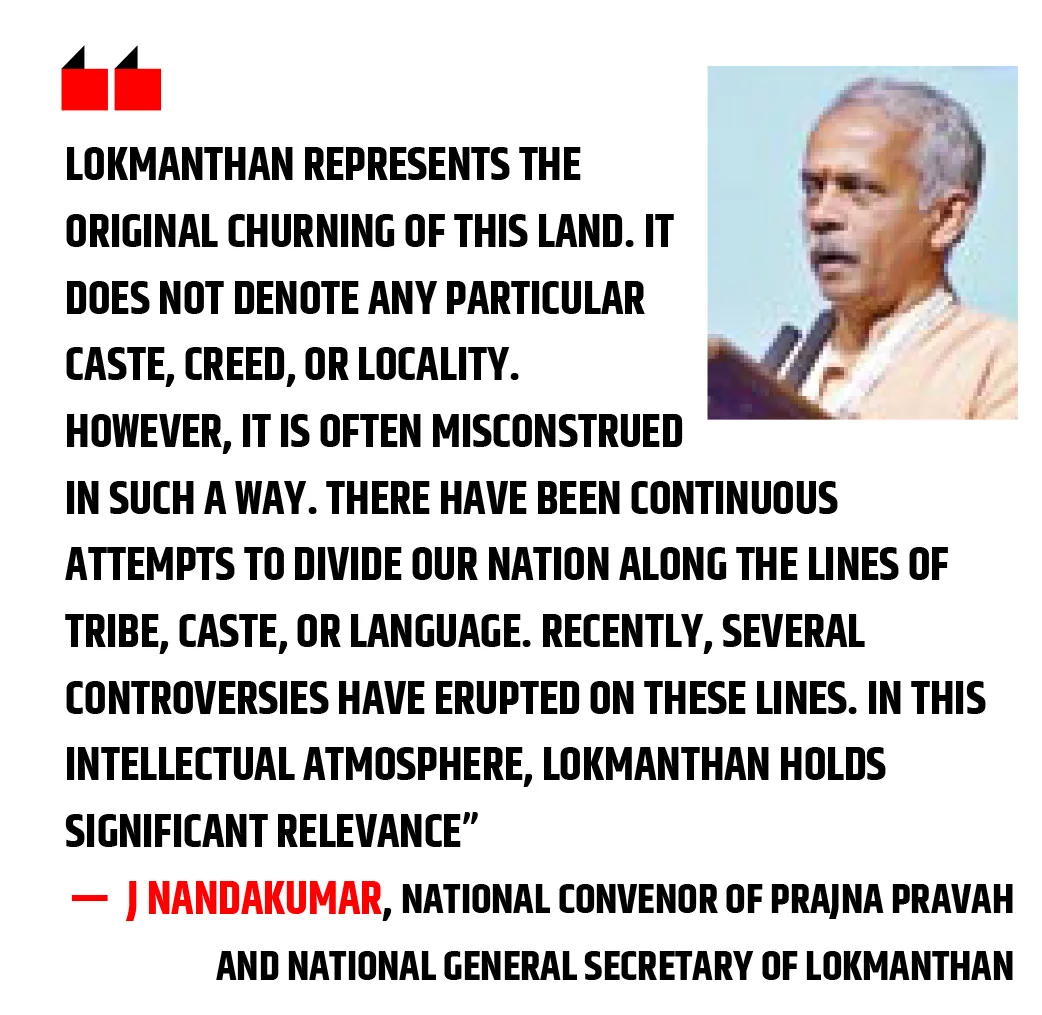
He also discussed historical significance of tribal communities like the Gonds, who once ruled the Gondwana region, and Rani Durgavati, who valiantly fought the Mughals. Other tribes, such as the Kolams, were renowned for their craftsmanship, while the Lambadas were prominent salt traders. However, during British colonial rule, these communities were criminalised, and their contributions and governance systems were overlooked.
Session 2: Lok Jeevan mein Vijnan
Acharya Devvrat, Governor of Gujarat in his presidential address of the session titled “Lok Jeevan Mein Vijnan”, called for a transformative approach to agriculture rooted in the wisdom of Bharatiya knowledge systems.
Drawing from his personal experiences, Acharya Devvrat shared insights from his agricultural experiments, where he successfully implemented organic farming techniques in his fields. The Governor emphasised the need to shift back to organic farming practices. Organic fertilisers, he noted, not only restore the vitality of the soil but also mitigate the effects of global warming by reducing carbon emissions.
In his address, Dr Anirban Bandyopadhyay, a senior scientist at the National Institute for Materials Science (NIMS) in Tsukuba, Japan, who travelled directly from Japan to attend the event, explored the profound scientific insights and discoveries of ancient Bharatiya Rishis, emphasising their relevance to modern science.
He emphasised how our sages, through their unique blend of empirical research and introspective inquiry, explored both the vastness of the cosmos and the intricacies of the microscopic world. Dr Bandyopadhyay articulated that the holistic understanding of the universe and the body—both internal and external—was an extraordinary feature of Bharat’s ancient knowledge systems, a wisdom that remains unparalleled and continues to intrigue modern science.
Dr Bandyopadhyay shared insights from his own scientific experiments on the subconscious mind and his research into atomic triplets, linking these to concepts in quantum physics. He expressed profound respect for the mathematical genius and metaphysical exploration of ancient Bharatiya scholars. He recalled the contributions of Aryabhatta, Brahmagupta, Bhaskaracharya, and Baudhayana, emphasising how their pioneering works laid the foundation for Bharatiya scientific achievements and continue to inspire advancements in mathematics and astronomy, whose writings prefigured many modern scientific theories.
At the event, Professor Neerja A. Gupta, Vice Chancellor of Gujarat University, shared her vision for integrating Bharatiya knowledge systems into the academic landscape. She highlighted the university’s efforts to promote research on socio-cultural issues impacting tribal communities and emphasised the importance of blending traditional wisdom with modern scientific approaches.
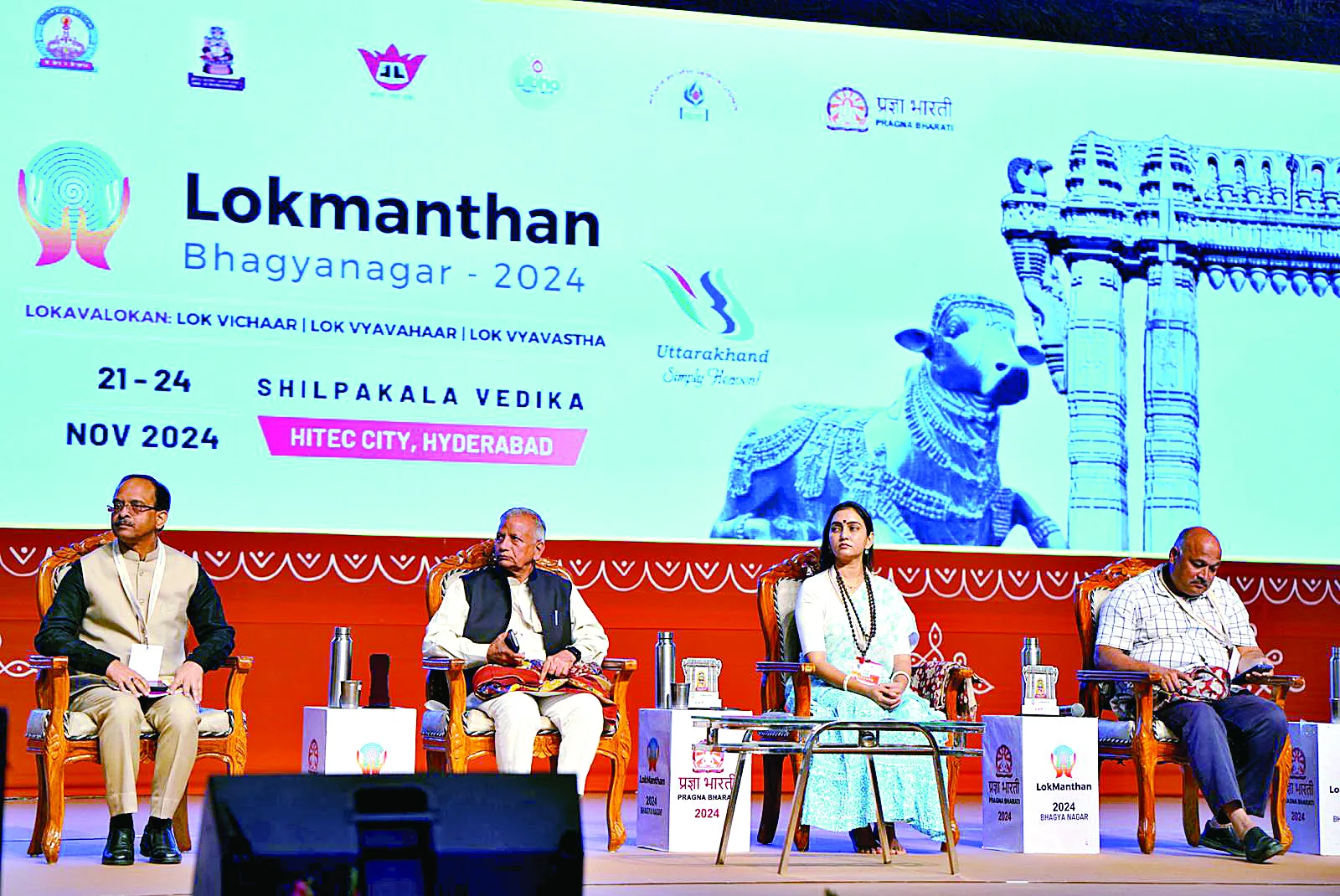
On November 22 morning, Sun worship, an ancient practice of the Romas from Armenia, was showcased at LokManthan 2024 in Bhagyanagar.
Day 2: November 23
The second day of proceeding began with an evocative ‘Fire Rituals’ performed by guests from Lithuania, representing followers of Roma tradition—an indigenous religion in Lithuania, notably the last European country to adopt Christianity under political duress, which has preserved many of its ancient rituals and practices in its rural heartlands.
Session 1: Lok sahitya
The second day’s first session was on the theme of ‘Lok Sahitya’, which focused on native language, their role in our lifestyle, contribution and representation in our day-to-day lives.
While speaking on the topic, Dr Kasi Reddy Venkat Reddy, Retd, Professor of Telugu Literature from Osmania University, pointed out the widespread diversity prevalent in our literature. He shared insights into Bharatiya Sanskriti through Lok Kahaniya. He mentioned that numerous people have been compiling these lokgeets, naming individuals like Pt. Raghunandan, Dr P Bhaskar, and Prof D Rama Raju. He cited some lok kahaniya based on the Ramayan, as well as many lokgeets based on the same epic, all in Telugu, showcasing how Bhagwan Ram has been revered in South Bharat as well.
Dr Vidya Vindu Singh, a Padma Shri Awardee, and renowned author, detailed the culture of epics being sung in lokgeets and kahaniya. She highlighted the emotional and sensitive approach of the Lok towards nature, citing practices like not plucking leaves at night or not fetching water from a well, assuming it is sleeping. She explained how in Bharatiya tradition, everything is considered to have human qualities, even inanimate objects, giving an example of not pouring water on a hot pan as it might ‘hurt’ it. She also criticised modern media, particularly filmy songs, for degrading societal values, advocating the need to popularise oral traditions.
Dr Singh also discussed the lack of solution-focused discussions, highlighting that the sentiment of Ekta (unity) acts as our Surakhsha Kavach (protective shield), preventing any divide between Swa and Pra. She noted that cultural values began to degrade with secularisation, questioning how a community can survive without its religious roots, and urged a return to these roots.
Dr Sachchidanand Joshi, Member Secretary IGNCA, who also delivered the presidential address, praised the efforts towards decolonisation. He proposed that since the songs and essence of Bharat are inherently Lokgeet and Lok Arth, these efforts should be termed ‘Bharat Manthan’.
Session 2: Bharatiya Lok Chetna Mein Paryavaran
Shipra Pathak, known as the “Water Woman” and Founder-Director of the Panchtatva Foundation, captivated the audience with her eloquent insights into Bharat’s enduring cultural and environmental legacy. She began by acknowledging the countless unsung heroes who have dedicated themselves to Maa Bharati, emphasising lok se bhog, bhog se yog, to underline the harmony between resources, their usage and spirituality. Reflecting on her journey, Pathak shared that she does not work on water by choice but feels chosen by rivers, especially Narmada Mata, to honour and preserve them. She stressed how Nadi Sanskriti (river culture) has been instrumental in sustaining Bharat’s cultural unity despite centuries of invasions and colonisation, serving as a foundation for Bharatiya civilisation.
Reclaiming the legacy of a forgotten queen
A performance showcasing the rule, valour, and legacy of Maharani Rudramma Devi was also held at Lokmanthan 2024. Her idol was also placed at the Shilpakala Vedika premises, attracting participants and visitors.
Maharani Rudramma Devi is one of the least understood figures in Bharatiya history and has been misrepresented by certain vested individuals in society. She has been portrayed as an aggressor, with some sections of society depicted as victims of persecution during her reign. However, the reality is entirely different. She herself came from a very humble background, belonging to the Katnaki Janjati. Her community rose to prominence, becoming rulers and subordinate rulers under the Chalukyas and Rashtrakutas. During their subordinate rule, they used names like Gundaya, Prolaya, and Beethya. However, after becoming sovereign kings, they adopted Sanskrit names such as Mahadeva, Rudradeva, and Ganapatideva while retaining their humble origins. Ganapatideva’s daughters were Mallya Amma and Kundamba Amma, whereas Rudramma Devi’s daughters were Mumbanamma, Rudramma, and Ruiamma.
Breaking all barriers in the 13th century, she became a woman ruler of this country and governed for 30 long years — a record that remains unbroken to this day. Maharani Rudramma Devi is a great icon for every Bharatiya. She established 72 districts, which continue to exist even today across Telangana, Andhra Pradesh, Chhattisgarh, Maharashtra, Tamil Nadu, and Karnataka. These districts endured even after her rule. Maharani Rudramma Devi was also a great warrior, having fought over 70 battles. She lived to the remarkable age of 82 and fought her last battle at the age of 81.
She expressed alarm over the growing use of chemical-laden products, noting that bathrooms once limited to a single toothpaste now overflow with harmful items. Rejecting the notion of tree planting as a Western concept, Pathak emphasised that reverence for nature has always been integral to Bharatiya culture.
Dr Prasad Waman Deodhar, Chairman of the Bhagirath Gram Vikas Pratishthan, shared innovative approaches to obtain sustainable rural development. He spoke about converting animal and cow manure into eco-friendly fuel through biogas plants. He explained how his organisation is setting up such plants in villages, providing essential support to rural communities with minimal financial burden, thus contributing to environmental conservation and rural empowerment. He argued that subsidies often devalue sustainability initiatives, whereas community-driven efforts like biogas plants bridge traditional knowledge with modern technology.
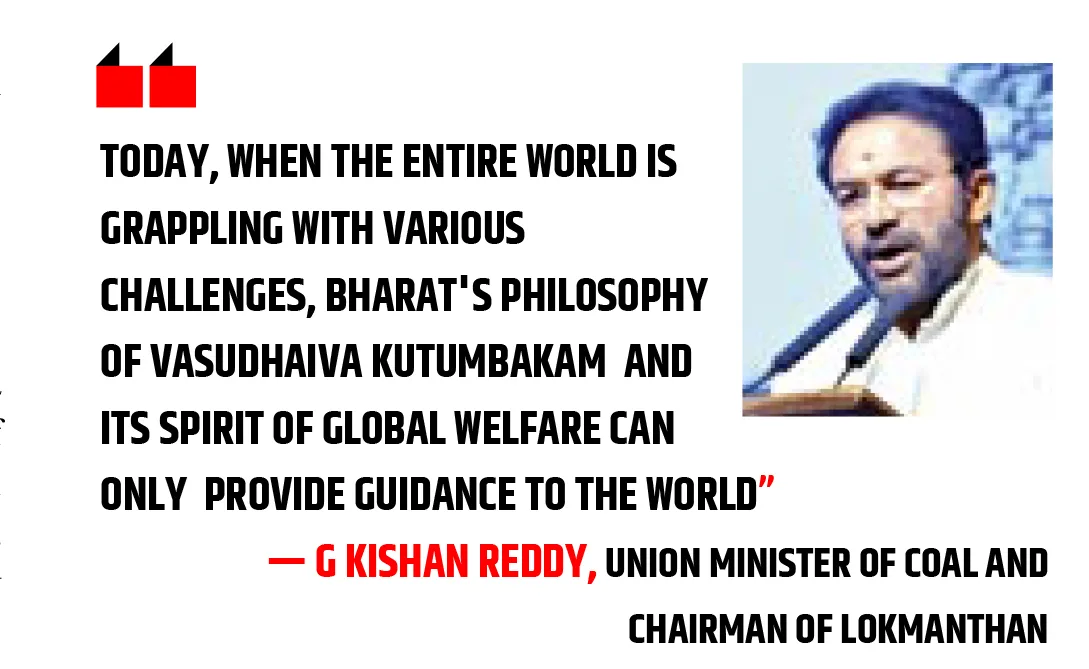
Gopal Arya, an environmentalist and Akhil Bharatiya Paryavaran Sanyojak of the RSS, called for the revival of traditional systems like Haritha (green living). He stressed the importance of integrating public awareness, participation, and collective movements to protect Jal, Jameen, Jungle, Janwar and Jan (water, land, forests, animals, and people).
Session 3: Lok Arthashastra
MD Srinivasan, Founding Chairman of the Center for Policy Studies, emphasised the foundational role of Vaarta—agriculture, trade, and animal husbandry—in Bharat’s economy, with the king serving as the protector of both Dharma and Vaarta. Citing Deendayal Upadhyaya’s vision, Srinivasan advocated for Bharat’s civilisational assertion and the revival of agriculture as the top priority. He highlighted India’s low agricultural productivity (2.3 tonnes per hectare) and called for sustainable irrigation systems to reduce dependency on rainfall. Drawing from Vedic literature and the Bhagavad Gita, he underscored the ethical duty of ensuring food security and equitable distribution as essential elements of governance.
Sandeep Singh, Independent Director at Choice International and IIM, spoke on Bharat’s resilience as a wealth generator despite centuries of exploitation by Islamic invaders and European colonial forces, particularly by the British. He attributed this to Lok Vidya (indigenous knowledge) and Lok Artha (local economies), particularly the centrality of temple economies. Using examples like Kanchi, Dhakeswari, and Sambhaleswari, he illustrated how temples sustained economic activities through rituals, trade, and festivals. He urged the revival of temple-centric economic systems to strengthen Lok Tantra (democracy) and restore the traditional role of temples in Bharat’s economy.
Dr Kanakasabhapati, vice president of TN BJP and secretary & trustee of the Dr. Syama Prasad Mookerjee Research Foundation, illustrated Bharat’s entrepreneurial spirit with examples like Rajkot’s diesel engine innovations and Namakkal’s transportation networks.
In his speech, he said, “We became poor after the plunder by British colonialists, but today, Bharat boasts the largest number of entrepreneurs and workforce, with a rapidly growing economy.” He stressed the pivotal role of the family system and community networks in India’s success. “Even when half the country was below the poverty line in 50s and 60s, savings were still around 10 per cent. Today, it’s about 30 per cent, explaining the huge remittances from NRIs.”
He highlighted Bharat’s entrepreneurial strength with 60 million enterprises employing crores, driven by family and jati-based networks fostering growth and self-reliance. He also praised grassroots innovations, noting that 30 per cent come from the uneducated, and emphasised the vital role of women in sustaining the economy through cultural wisdom and family enterprises.
Session 4: Lok ki Sarvasamaveshi Vyavastha
The 6th session of LokManthan, titled ‘Lok ki Sarvsamaveshi Vyavastha’, was chaired by Prof. Vishnukant S Chatapalli, with Dr Harsh Chouhan as the speaker and Prafulla Ketkar, Editor of Organiser, as the moderator.
Dr Harsh Chouhan remarked, “Inclusive growth is generally perceived as an issue of activism. The words’ inclusive’ and ‘development’ are concepts we have borrowed from elsewhere because whenever we think about ‘sarv’ (all), we don’t include ourselves in the thought process.”
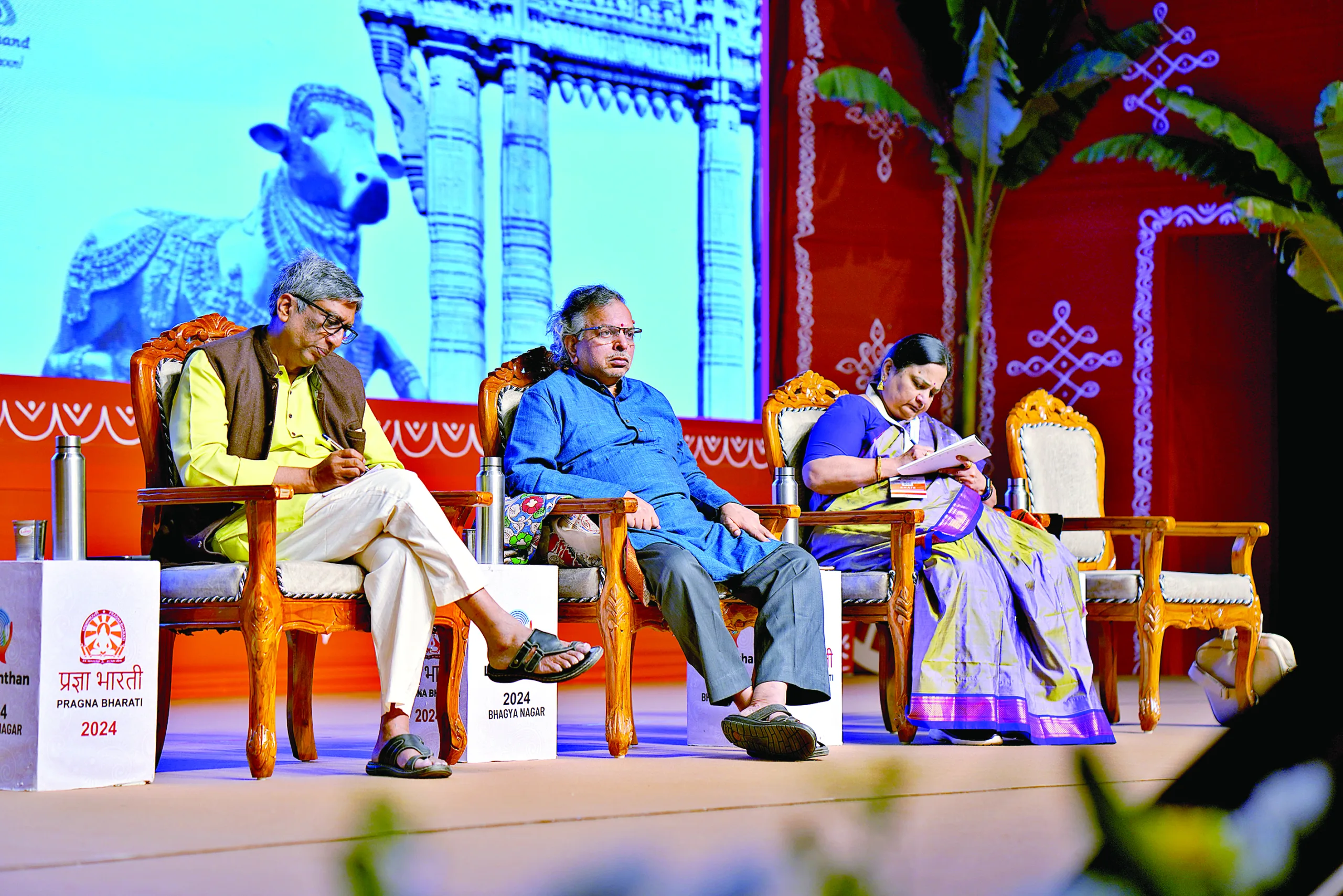
He further said, “Two words have deeply impacted India and divided us—asprashya (untouchable) and asabhya (uncivilised). While the origin of asprashya is unclear, asabhya is a British term that has had the greatest impact on tribal communities.”
Recalling his student days, Dr Chouhan said, “When I was studying in the city, I observed a perception that tribal people are dangerous and wear strange clothes. This perception arose because people read textbooks written by the British and watched films that portrayed tribal communities in a negative light, without ever visiting their villages.”
He added, “The British referred to tribal people as the ‘White Man’s Burden.’ From this, we developed the belief that we must bring them to the ‘light’ and work for their development. When we talk about sarvsamaveshi (inclusivity), we must think about what sarv (all) is included.”
Dr Chouhan explained, “The tribal community does not believe in individual ownership; they operate on the principle of community ownership.”
Chair of the session, Prof Vishnukant S Chatpalli, said, “To unify this philosophy, it is important to recognise that the way of life remains consistent across the length and breadth of the country. However, to truly understand inclusion and systemic harmony, one must recall the ancient structure of the village”.
Day 3: November 24
Session-1: Lok Suraksha and Nyaya
Prof Nagaraj Paturi, senior Director and Dean at INDICA, said, the word “Lok” is known as “Janpada” in Telugu, and “LokManthan” translates to “Janapada Manthanam.” Historically, there was a village head or “Mukhiya” of the panchayat who resolved issues before the colonial period. Before the British arrived, there existed a local village justice system. Over the past 30 years, I have attended hundreds of such dispute settlements. Let me tell you, in India, we didn’t have this urban-rural divide; every major city is essentially a cluster of villages. To date, panchayats are being organised, which is what we call “lok nyaya.”
Regarding “Lok Suraksha,” there was a system of village policing or security. People often use the term “village watchman,” which has pejorative connotations, suggesting there was just one watchman like in modern societies, but that’s incorrect. In Telugu, we call him a “talari.” Because traditional systems are preserved through the Panchayati Raj system, the role of the “talari” continues to exist across Bharat. There were often numerous “talaris” in a village. He mentioned a 15th-century story from Kashi Khandamam where a person was arrested by “talaris” for stealing fruits from a temple, indicating the robustness of this security system. One aspect of security was protection from wild animals; those who succeeded in this were celebrated by the villagers. Another notable feature was “vyayamshalas” or gymnasiums in villages, where activities like “dand vyayam” and “dand yudda” were part of village culture. These activities were demonstrated during village processions, and young people enjoyed being admired for their valour. Weapons like swords, lathis, and maces were admired, indicating how villages promoted being armed, cavalry arrangements, and more
Dr Shri Krishna Jugnu, senior academician and Indologist, asked what is in the “lok” (community) is also in the “shlok” (verse). All the scriptures and traditions are part of the community; all the policy texts belong to the community—Manu, Kamandak, Chanakya, Saptarishi. For instance, Mallpuran connected to Gujarat, explains how ‘mall’ (wrestlers) protect the community. ‘Mansollas’ also conveys the same message, and Brihad Yatra teaches us similarly. Varahamihira’s works like Laghu Yatra, Dirgh Yatra and Brihad Yatra highlight this. Many castes exist here because they ensure security; in Rajasthan, for example, groups like Sansi, Mogia, Kanjar, Bawri, and Pardhi have settled near borders to oversee security. Even today, Bharat acknowledges them, and we, coming to the cities, remember them through grand events. There are “Gadegal,” which have laws inscribed on them.
In her presidential remarks, Prof. Santishree Dhulipudi Pandit, JNU VC, said that we are a society that values feminism and that we do not need Western groups to teach us about it. We address all our Gods by the names of their consorts—Sita Pati, Uma Pati, Lakshmi Pati—we do not need to be taught feminism. In Sangam literature, Kannagi burned down the Pandyan Empire when she was wronged, showing the power of women in Indian history. Indian dynasties like the Chola and Marathas spread our culture across the seas to Southeast Asia and other parts of the world.
Session 2: Vikas Ki Lok Awdharna & Prakriya
In his talk, Prof Ganesh Bagaria said, “The prevailing concept of development sees society as an inert matter, which is why problems appear to escalate. We talk about Sustainable Development Goals and aim for zero poverty, but from 1990 to 2027, the outcome shows that poverty persists with numerous side effects. The rise in GDP has only widened the gap between the rich and the poor. Therefore, there is a need to understand the idea of development in Bharat through the Bharatiya concept of Vikas, not just for Bharat but for the entire world. Coexistence is the reason there’s potential for development here. Every particle has the potential to perform four kinds of actions: knowing, accepting, understanding, and doing. This is how development within each particle is perceived”.
Mahesh Sharma, in his talk, stated that the truth is the very concept itself forms the foundation of development. In our tradition, what is this concept? Ekam sat vipra bahuda vadanti – there can be many thoughts, but we can hold them together. It’s also said that a state should be such that its subjects live happily, with an equal share in everyone’s heart. Concepts can be proven, but beliefs cannot. How can we believe we have developed?
A video was screened from Jhabua about a tradition called Halma, where in four matches, 15,000 villages came together to serve Mother Earth at Hathipao Hill, Jhabua, MP. All these people seen going to work were heading to conserve water, using their own resources, and with a spirit of selflessness.
Dr JK Bajaj, former Chairman of ICSSR and Padma Shri awardee, praised the Bhil community for embodying the true spirit of Bharatiya development. He highlighted the challenges of the Jhabua region, particularly in water management, yet the Bhils continue to grow high-quality wheat, showcasing their resilience and agricultural expertise.
“What is the concept of development in Bharat? The people of Bharat know this because it is embedded in their culture and tradition. There are three ways to understand this: one, technically; two, by going among the people to see for ourselves; and three, by understanding the system, which looks at how life was in Bharatiya communities before the arrival of the British. What concepts do we see here? Was there development? Firstly, these developed villages have a per capita output that is three to six times higher than current needs. Here, you find mandirs, wells, and ponds”, Dr JK Bajaj said.
Valedictory Session
“There is no need to respond to those whose experiments have failed over the last 2,000 years. Our focus should be on guiding our own people—those entangled in false narratives or countering them. On the global stage, we will play by our predefined parameters and in our unique way,” said RSS Sarsanghchalak Dr Mohan Bhagwat in his valedictory speech on November 24.
Delineating Dharma
In his concluding address, Dr Mohan Bhagwat provided a profound perspective on Bharat’s eternal concepts of Dharma and creation. He emphasised that while the world races ahead without contemplating its destination, Bharat has always reflected on the deeper truth of unity and oneness.
Family is the first initiative of social change: Dr Mohan Bhagwat
In LokManthan, RSS Sarsanghchalak Dr Mohan Bhagwat also addressed a program on Kutumb Prabodhan (Family awakening). He spoke to 2050 people of samyukta parivars (joint family) that shares same kitchen. “In Bharatiya tradition, a kutumb is not just a coincidental gathering but a harmonious union with the fragrance of relationships. It is a blood relation. The kutumb is the entity where every member has an inherent system of learning and teaching. Unlike animals or birds, whose children leave once they grow up, humans do not follow the same pattern. In our tradition, even after growing up, all members live together as part of the kutumb”, Dr Mohan Bhagwat said.
“The kutumb instills a sense of social belonging. It teaches affection and togetherness. It serves as a kind of training equipment. The kutumb also extends its boundaries to the surroundings; for instance, if someone comes to our doorstep asking for help, they are not turned away empty-handed. Children in the kutumb learn from such acts that even those outside the family deserve generosity and help”, he said.
He further said that, “The kutumb is the fundamental social unit. Traditionally, it has also been an economic unit in our country. From the self to the kutumb, from the kutumb to the village, from the village to the entire society, and from society to humanity, encompassing the entire world and creation. The understanding of these relationships begins within the kutumb. This wisdom must be passed on to the younger generation”, he said.
He further stated that, “our new generation must remain rooted in Bhartaiya values. They can be modern without being westernised. Amidst an atmosphere of indulgence, we must impart the message of sacrifice. We will also offer values and wealth. We will bring the science and will inherent knowledge; this is the responsibility of Kutumb”.
“The cure for societal ailments also lies within the kutumb. Hence, among the five steps for bringing transformation in society, the first is the kutumb. The other four are social harmony, Swadeshi, environmental conservation, and civic discipline”, he said.
Dr Mohan Bhagwat said, “The origin of Lok (people), Srishti (creation), and Dharma (righteousness) is simultaneous. These three coexist and will remain until the end of time, which is why they are ‘Sanatan’. Because these three are together, existence is possible. Everything runs with the support of these three. This truth was recognised by our ancestors. It is not our exclusive inheritance; it is a universal truth because our ancestors discovered it. “Our life is Sanatan. Our nation is a Sanatan nation. Our clothing might have changed, our food habits might have evolved, but within, we all remain one.”
Popularise Lokmanthan in Rural Bharat
Dr Bhagwat drew parallels from Puranic symbolism, stating, “Just as Halahala emerged during the churning of the ocean, challenges will arise. But we are prepared to bear them and serve Amrit for the welfare of all.” He also called for taking the LokManthan initiative to rural Bharat, urging smaller gatherings in villages to engage with grassroots voices. He further stated, “There is unity even in diversity, provided one seeks it. If there is unity, then everything belongs to us. Only when everyone is happy can we be truly happy. If one truly desires peace and contentment, there is no other way but the spirit of Sarve Bhavantu Sukhinah (May everyone be happy). In our country, all resources were owned by society, but then foreign rulers, especially the British, came and seized our resources. Gradually, this brought us to our current state, where we have to assert that something belongs to us. This is both unfortunate and shameful.”
Lok Samvaad: Awakening of Nationalistic ideas and cultural essence
The Lok Samvaad Session at LokManthan Bhagyanagar 2024 emerged as a transformative forum, amplifying Bharat’s intellectual and cultural essence while addressing critical contemporary challenges. The session witnessed profound insights through dynamic themes, thought-provoking discussions, and inspiring book launches, cementing its significance as a national movement of ideas.
Lok Suraksha
K Keshavanath, Editor of Lokahitham, discussed the importance of safeguarding Bharatiya cultural values against external influences. The book Missionary Mayajalam by Sudha Mohan was released during the session, shedding light on critical cultural challenges.
Lok Utsavalu
Dr Bhaskara Yogi, columnist and author, and Prabhakar Rao Kadiyala, writer of Sataka Satakam, highlighted the significance of festivals in nurturing communal unity and spiritual bonds. The session also marked the launch of Sataka Satakam, a work celebrating cultural and poetic heritage.
Lok Parivartan
Appala Prasad, Convenor of Samajika Samarasata Vedika, focused on social transformation through inclusivity and mutual respect, presenting strategies to foster harmony and equity.
Rediscovering Bharat & Swadeshi Jeevan
Pawan Gupta, founder of SIDH, advocated for Swadeshi lifestyles and the revival of Bharatiya education systems to address contemporary societal challenges. The session included the launch of Chaduvulu Chettu by K Satyadeva Prasad Rao and the Telugu translation of Rabindranath Tagore’s Swadeshi Samajam, which emphasised the ethos of self-reliance.
Temple Economics
Sandeep Singh explored the economic and cultural significance of temples, highlighting their role as hubs for community development and cultural preservation.
Pancha Parivartan
Dr Manmohan Vaidya, Akhil Bharatiya Karyakarini Sadasya of RSS, presented the concept of Pancha Parivartan, addressing governance, education, economy, spirituality, and environment. He emphasised the need for a holistic approach to societal rebuilding.
Pointing out that foreign invaders were never capable of defeating Bharat on their own, Dr Bhagwat said even today, they are not capable. “This happened because we deviated from righteousness. We forgot who we are, and we forgot our self-respect. Why did we forget? Because we lost sight of our life’s purpose. What is Dharma? It is living and moving together despite all the diversity. If Dharma sustains, the creation thrives,” he said.
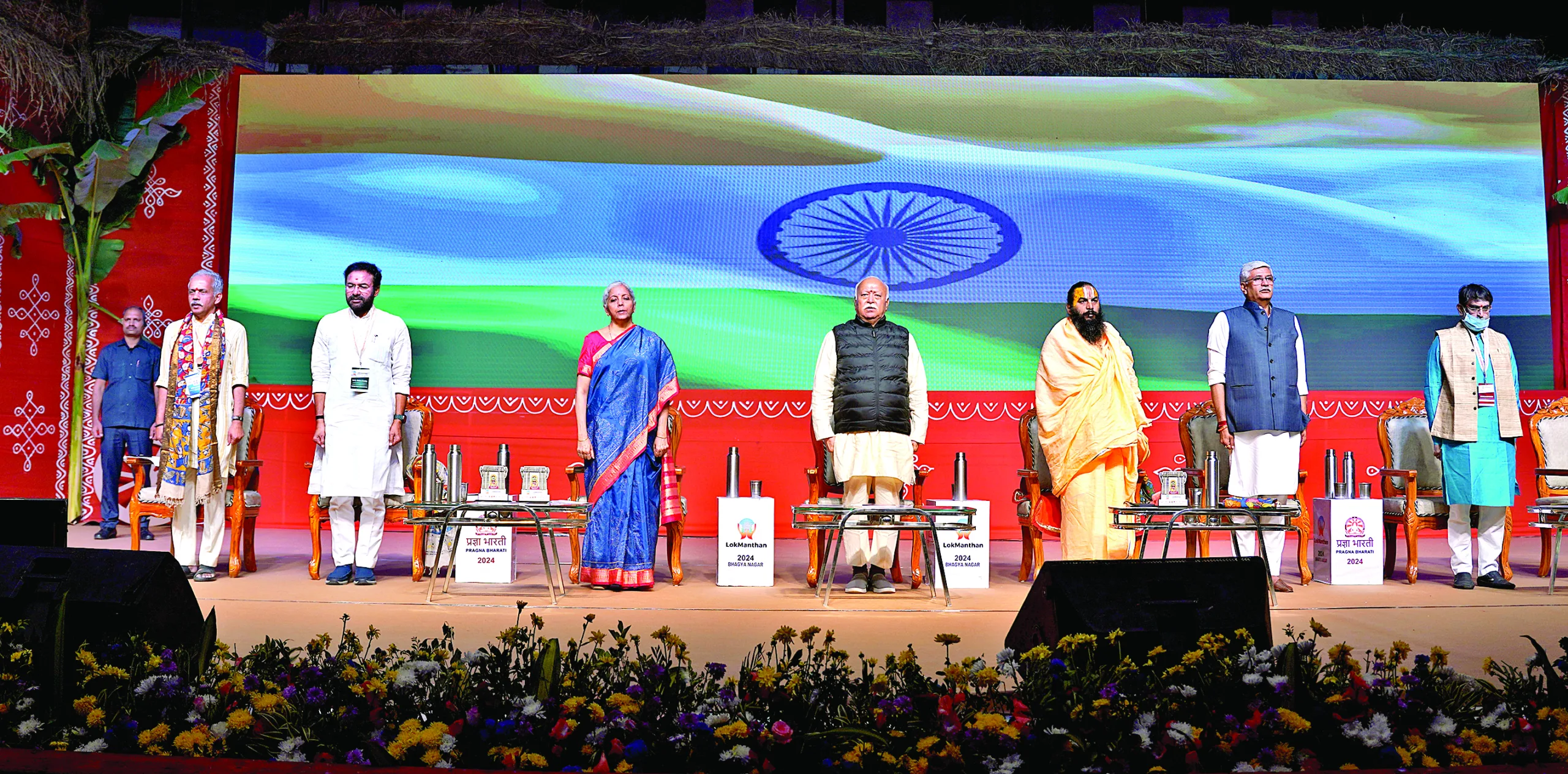
Addressing the gathering, Acharya Mithilesh Nandini Sharan ji Maharaj, in his aashirvachan, said, “Without Ayodhya, the spirit of Lok Mangal (public welfare) cannot be clearly envisioned, at least for Bharat. This is why, among the most emphasised words in the glory of Shri Ram, one is Lokabhiram (one who is delightful, beloved, or pleasing to the world or people).
“Lok manifests itself through a transcendental essence that reflects an otherworldly power. This is why Indian philosophy declares, Sarvam Khalu Idam Brahma (“Everything here is Brahma”). Those who perceive this essence distinguish between higher and lower, prescribe rules, and establish prohibitions. They do this because when this transcendental essence manifests itself in the realm of Lok through the dimensions of time and space, it reveals itself through nature. Yet, along with this, distortions also emerge”, he said.
“I have often said that Bharat is a culture-based country. Unfortunately, influenced by global trends, we are increasingly becoming civilisation-oriented. But Bharat is not a civilisation-based nation. Civilisation is external and artificial, whereas culture is intrinsic and fundamental. When we delve into the essence of culture, we find that it is rooted in Dharma”, he said.
“If we undertake Lok Manthan (churning of society), what will emerge? First, we must understand the purpose of this churning. Vedas explain that the essence of churning is to soften something hardened, to crush it, to liquefy and simplify it. Manthan aims to make hardened traditions, practices, or emotions more fluid and accessible. Over generations, practices and traditions sometimes become rigid. This rigidity, like clotted blood in the body, manifests as a severe ailment. Similarly, in our nation, some traditions have become distortions over time. However, because they are ancient, we continue to support and advocate for them. Churning breaks down these rigid traditions and makes them fluid, soft, and open to dialogue. It simplifies communication and fosters understanding among individuals”, he said.
The LokManthan Bhagyanagar 2024, concluded on November 24 with a resounding call for Bharat to reclaim its civilisational ethos and assert its unique approach to global challenges.


















Comments